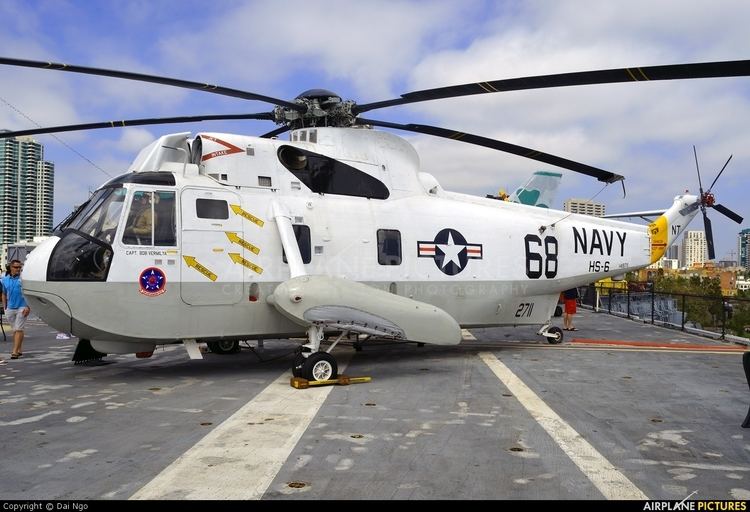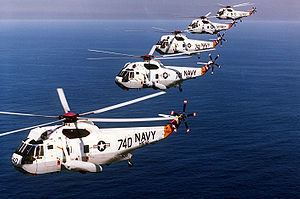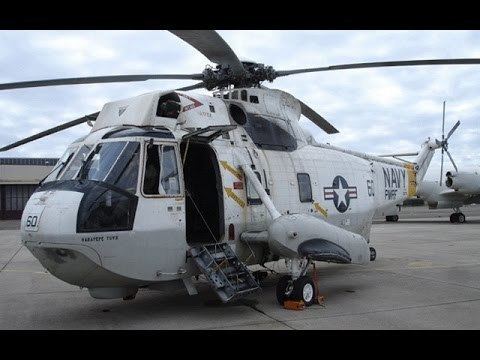Top speed 267 km/h Length 17 m | Range 1,000 km Introduced 1961 Engine type Turboshaft | |
 | ||
Unit cost 6,400,000–6,400,000 USD (2012) | ||
Sikorsky sh 3 sea king asw sar
The Sikorsky SH-3 Sea King (company designation S-61) is an American twin-engined anti-submarine warfare (ASW) helicopter designed and built by Sikorsky Aircraft. A landmark design, it was the world's first amphibious helicopter and one of the first ASW rotorcraft to use turboshaft engines.
Contents
- Sikorsky sh 3 sea king asw sar
- Origins
- Further developments
- Design
- Operational history
- US military
- Sikorsky designations
- United Aircraft of Canada
- Westland
- Agusta
- Mitsubishi
- Operators
- Aircraft on display
- Specifications SH 3
- References
Introduced in 1961, it served in the United States Navy as a key ASW and utility asset for several decades before being replaced by the non-amphibious Sikorsky SH-60 Seahawk in the 1990s. The type also proved popular in civil service and with foreign military customers. As of 2015, many remain in service in nations around the world. The Sea King has been built under license by Agusta in Italy, Mitsubishi in Japan, and by Westland in the United Kingdom as the Westland Sea King. The major civil versions are the S-61L and S-61N.
Origins

During the Cold War, the Soviet Navy built up a large and varied fleet of submarines which at one point was in excess of 200 operational submarines. The US Navy decided to counter this threat perusing the improvement and development of various anti-submarine warfare (ASW) capabilities, which would result in the development of the Sea King. During the late 1950s, the US Navy was keen to take advantage of newly made progress upon turboshaft engines by commissioning a sizable navalised helicopter for their purposes. Sikorsky received a request from the US Navy to design a new turbine-powered helicopter capable of performing the ASW mission; the specification provided included a dipping sonar, a mission endurance of four hours, and the ability to support a weapons load of 840 lb.

In 1957, Sikorsky was awarded a contract to produce an all-weather amphibious helicopter for the U.S. Navy. As per the earlier specification, this new helicopter was to excel at ASW; in particular, it would combine the roles of hunter and killer, as these duties had previously been carried out by two separate helicopters. It was also the first helicopter to be procured under the US Navy's new weapon system concept, under which Sikorsky was responsible not only for the design and production of the airframe itself but all of the major onboard systems, such as the sonar, navigational equipment, electronic devices, and support equipment. As such, the navigation suite for the rotorcraft was developed jointly by Sikorsky and the US Navy.

Key features of the emerging ASW helicopter would include its amphibious hull, enabling the rotorcraft to readily perform water landings, and the adoption of a twin-turboshaft engine arrangement that enabled a larger, heavier and better-equipped aircraft than had been possible with prior helicopters. The designation HSS-2 was applied to imply a level of commonality to the earlier HSS-1, should political sentiment turn against the development of an entirely new rotorcraft. A total of ten prototypes were produced to support the development program. In March 1959, the first prototype conducted its maiden flight.
In early 1961, a pair of prototypes were stationed on board the aircraft carrier Lake Champlain to fulfill a demand for carrier suitability trials to be conducted; these trials, which had involved testing the folding mechanism of the main rotor blades and a series of takeoffs performed during winds of up to 50 MPH, were completed successfully in mid-1961. Shortly after the competition of suitability trials, the US Navy formally accepted delivery of the first HSS-2 rotorcraft, which would be subsequently re-designated as the SH-3A, in September 1961. Upon entering service, it was not only the largest amphibious helicopter in the world, but also held the distinction of being the first all-weather rotorcraft to reach production status for the US Navy.
In late 1961 and early 1962, a modified U.S. Navy HSS-2 Sea King was used to break the FAI 3 km, 100 km, 500 km and 1000 km helicopter speed records. This series of flights culminated on 5 February 1962 with the HSS-2 setting an absolute helicopter speed record of 210.6 mph. This record was broken by a modified French Sud-Aviation Super Frelon helicopter on 23 July 1963 with a speed of 217.7 mph.
Further developments
The base design of the Sea King had proved sound and several aspects were judged to be potentially useful for other operators, thus Sikorsky elected to pursue the further development of the Sea King for other markets beyond the US Navy. One of the major variants of the Sea King to be produced was a model for civil operators, which was designated as the Sikorsky S-61L. The first operator of the S-61L was Los Angeles Airways, who introduced the type to service on 11 March 1962. Another noteworthy Sea King variant, the significant change this time being the adoption of a conventional hull, the Sikorsky S-61R, was also concurrently developed for transport and search and rescue (SAR) duties, this type being extensively operated by the U.S. Air Force and the U.S. Coast Guard.
In US Navy service, the initial SH-3A model of the Sea King would be progressively converted into the improved SH-3D and SH-3H variants; these featured more powerful engines and improved sensors that gave the type greater operational capabilities as an ASW platform. It was also common for Sea Kings to be converted for non-ASW activities, these roles included minesweeping, combat search and rescue, and as a cargo/passenger utility transport. The aircrew on ASW-tasked Sea Kings were routinely trained to carry out these secondary roles as aircraft could often be quickly adapted to perform different missions in the face of operational needs.
The Royal Canadian Navy (RCN) became a major operator of the type (see Sikorsky CH-124 Sea King), the Sea King continues to operate as Canada's dominant maritime helicopter 50 years following its introduction to service in 1963. One notable innovation in Canadian operations, which was subsequently adopted by several other nations, was the use of a winch 'hauldown' landing method, referred to as a 'Beartrap'. This device considerably increased the ability of Sea Kings to land in difficult conditions, such as on small flight decks or during poor weather conditions.
In addition to aircraft manufactured by Sikorsky, several license agreements were issued to other firms to produce the type, such as Mitsubishi in Japan and Agusta in Italy. Another licensee in the United Kingdom, Westland Helicopters, would substantially modify the Sea King, producing the Westland Sea King. Unlike US Navy Sea Kings, the Westland Sea King was intended for greater autonomous operation. In total, Westland produced 330 Sea Kings; beyond British operators, export customers of Westland's Sea King included the Indian Naval Air Arm, the German Navy, the Royal Australian Navy, and the Royal Norwegian Air Force.
In the early 21st century, following their drawdown in US service, there have been a number of initiatives to refurbish ex-military Sea Kings for continued operations; in addition to civil operators, nations such as Egypt and India acquired refurbished former US Sea Kings to supplement their own aging fleets. While Sikorsky had ended production of the type during the 1970s, it was reported that nearly 600 Sea Kings were in operational service in 2009.
Design
The Sikorsky SH-3 Sea King is a twin-engine medium-sized amphibious rotorcraft. Many of the features on board the Sea King represented a considerable advancement over preceding helicopters. In addition to being fully amphibious and capable of operating under all weather conditions, it holds the distinction of being the first operational American helicopter to be able to simultaneously hunt and destroy submarines. Its twin-turboshaft powerplant layout gave the SH-3 a higher payload and greater reliability than previous anti-submarine helicopters. In the event of a single engine failing, the Sea King could continue flying on a single engine. The powerplant used on the Sea King was the General Electric T58-GE-8B, which was initially capable of generating up to 1,250 shp each.
In normal operations, the Sea King typically would have a four-man crew on board; these being a pilot and copilot in the cockpit, and two aircrew stationed within the main cabin area. When conducting anti-submarine missions, the rear aircrew would operate and monitor the aircraft's detection equipment and interpreted the sensor data that would be generated. For search-and-rescue missions, the Sea King's cabin could accommodate up to 22 survivors; in a medical layout, a maximum of nine stretchers plus two medical officers could be carried. In the troop transport role, up to 28 soldiers can be accommodated.
The Sea King features many design elements to support naval-orientated operations; the main rotor blades and the tail section can be folded via fully automated systems for compact storage onboard ships. The adoption of an amphibious hull allowed a Sea King to readily conduct a water landing and, being completely watertight, would enable the rotorcraft to remaining floating for prolonged periods upon the ocean's surface like a boat; deployable airbags in the aircraft's sponsons would add to the rotorcraft's stability and buoyancy, effectively resisting the pitching and rolling motions it would be subject to while present upon the water's surface. The hull design was also compatible with landing upon a wide range of challenging terrain, including ice, snow, swamp land, and tundra. Conventional wheels are installed in the sponsons for traditional land operations.
The armament fitted upon a Sea King could vary considerably. For anti-submarine missions, the aircraft could carry up to four torpedoes or four depth charges. For anti-ship duties, some models were outfitted to carry one or two missiles, typically Sea Eagles or Exocets. The Sea King could also be fitted to deploy the B57 nuclear bomb. ASW equipment used on Sea Kings has included the AQS-13A/B/E dipping sonar, specialized computers for processing sonar and sonobuoy data, various models of sonobuoys, ARR-75 Sonobuoy Receivers, and Magnetic Anomaly Detectors. The commonly fitted AKT-22 data link enabled the rapid dissemination of gathered sonar information to other friendly elements in range. Some later Sea King models featured digital navigation systems and overhauled cockpit instrumentation for night vision compatibility.
Operational history
The Sea King became operational with the United States Navy in June 1961 as the HSS-2. When the unified aircraft designation system was introduced, the aircraft's designation changed to SH-3A. It was used primarily for anti-submarine warfare: detecting and tracking Soviet submarines; in the event of an outright military conflict, they would have been used to launch attacks upon them as well. Sea Kings could also operate from offshore platforms to extend their surveillance and strike range. Nighttime ASW operations were possible, albeit posing considerable difficulty for the flight crew.
The Sea King also performed various other roles and missions such as search-and-rescue, transport, anti-shipping and airborne early warning operations. Aircraft carriers would typically deploy Sea Kings to operate near the carrier as a plane guard, ready to rescue air crew who crashed during takeoff or landing. They routinely transferred personnel and mail between vessels.
The Sea King was exported in large numbers to Brazil, Italy, Japan and the United Kingdom. Several operators have kept their Sea Kings in use for more than 50 years.
During the Vietnam War, SH-3s rescued the crews of downed aircraft at sea and over land, typically being equipped with self-sealing fuel tanks, multiple machine guns and heavy armor when performing such missions. Due to the type's greater range and the safety of having two engines, it was often used during rescue sorties into North Vietnam to retrieve downed aircrew. The Sea King was also used for medical evacuations and disaster relief efforts.
The SH-3 was the primary helicopter for retrieving manned space capsules starting with Mercury-Atlas 7 in May 1962. In February 1971, an SH-3A, operating from the amphibious assault ship USS New Orleans, recovered Apollo 14. A specialist search and rescue variant of the SH-3, the HH-3, also performed in this capacity.
Several Sea Kings, operated by the United States Marine Corps's HMX-1 unit, are used as the official helicopters of the President of the United States; in this capacity, the call sign 'Marine One' is used by the helicopter currently occupied by the President. As of 2012, a replacement helicopter fleet for the Sea King is pending under the VXX program. In 1992, the US Justice Department sued Sikorsky over allegations of overcharged component pricing and deliberately misleading US Navy negotiators. In 1997, the Justice Department issued further accusations against Sikorsky of willful overcharging on a contract to upgrade the Navy's Sea Kings.
During the 1990s, the Sea King was replaced in the ASW and SAR roles by the U.S. Navy with the newer Sikorsky SH-60 Sea Hawk. However, the SH-3 continued to operate in reserve units in roles including logistical support, search and rescue, and transport. On 27 January 2006, the SH-3 was ceremonially retired at NAS Norfolk, Virginia, by Helicopter Combat Support Squadron 2 (HC-2). They have been replaced by increasingly advanced variants of the SH-60 Sea Hawk.
US military
Sikorsky designations
United Aircraft of Canada
Westland
The Westland Sea King variant was manufactured under license by Westland Helicopters Ltd in the United Kingdom, who developed a specially modified version for the Royal Navy. It is powered by a pair of Rolls-Royce Gnome turbines (license-built T58s), and has British avionics and ASW equipment. This variant first flew in 1969, and entered service the next year. It is also used by the Royal Air Force in a search and rescue capacity, and has been sold to many countries around the world.
Agusta
Mitsubishi
Operators
Aircraft on display
Specifications (SH-3)
Data from Omnifarious Sea King, U.S. Navy Fact File.
General characteristics
Performance
Armament
